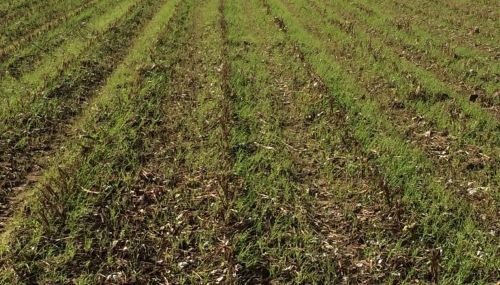Put Fall Cover Crop Plans in Place Now
Adopting of the use of cover crops is growing. Growers who plant covers recommend planning at least one season ahead. With fall planting around the corner, now is the time to get serious regarding cover crop planning.
There are many goals we can strive to achieve with cover crops. The choice of species to plant should be based on your needs. There are many sources of information in printed and online publications, as well as videos. One resource that can likely be the most valuable is to pick the brain of a neighbor who is currently planting covers. Don’t get too complicated or on too many acres to start with. Human nature is to start on a small scale, off the beaten path, and out of sight of the neighbors.
Cereal rye cover (Photo: Bill Robertson)
Multiple Factors to Consider
Matching cover crop species with the cash crop should be a primary consideration when selecting cover crops. A blend heavy on grasses is recommended with broadleaf cash crops such as cotton. Single species cover crops may help speed the learning curve when starting out. Cereal rye — often considered the cover crop with training wheels — is relatively easy to establish and to terminate. A single species of cover crop does not give us the diversity needed to achieve maximum soil health benefits. But cereal rye does get us a long way down the road, while providing the opportunity to see if we can farm with covers.
Seeding method is another important consideration. Most everyone will agree that drilling cover crops is the best way to establish them, especially large-seeded covers such as black seeded oats. However, having a drill, time, and labor may be a limitation. Aerial seeding just prior to the initial harvest aid application works well if that resource is available. Flying cover crops just prior to the initial harvest aid application in cotton works well if that resource is available. Many producers seed cover crops broadcast after harvest and stalk destruction with or without some form of tillage. This can be very successful if moisture and temperatures can ensure some growth before seasons end.
If broadcast surface–applied seeding is the best option, consider selecting species that spread uniformly with one another. This is another situation where a big and less aerodynamic seed like black seeded oats doesn’t fit as well.
Terminating the cover crop in the spring will present the next set of challenges. Some consideration of ease and timing of termination should be a part of the your cover species planning process.
Ask for Help
Many states are fortunate to have a group of producers who have learned — mostly through trial and error — how to make cover crops work for them and are willing to help share their experiences. It is just as important to know what doesn’t work as it is to know what does. These producers often work with groups including, but not limited to, University Extension and researchers, USDA-Natural Resources Conservation Service, Conservation Districts, USDA–ARS, and non–governmental organizations. Attend field days and meetings to get to know these people to get the most out of this important resource.
Incorporating the use of cover crops in a production system requires planning and the ability to accept moving out of your comfort zone at times. Benefits can be very rewarding. Lint yields may or may not improve with the use of cover crops, but conservation of natural resources through improvement in soil health is consistent. Whatever the reason you may have for planting cover crops, they must be part of your overall plan to work toward reducing production costs.











